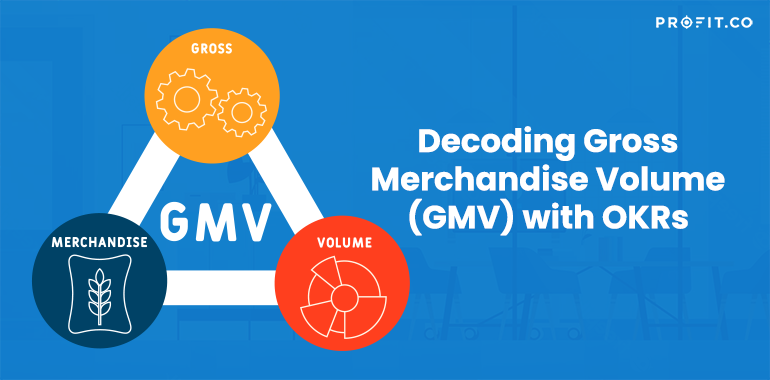This blog aims to demystify GMV, detailing its calculation formula and exemplifying its utility through a real-world scenario.
“If you really look closely, most overnight successes took a long time.”
What is GMV?
Gross Merchandise Volume is the total sales value of merchandise sold through a company over a specific period. It’s a significant indicator of the size and health of an e-commerce platform or marketplace. Unlike net sales, GMV doesn’t account for costs like returns, discounts, or delivery, it’s purely about the sales volume.
See remarkable results by focusing on GMV!
The formula for GMV Calculation
GMV shines a spotlight on a company’s sales efficacy and market reach, differentiating it as a gross indicator that tallies the platform’s facilitated transaction value rather than the platform’s direct revenue.
Calculating GMV is straightforward:

For platforms offering a diverse array of items or services, GMV aggregates the transaction values across all categories for the given timeframe.
Illustrative Example: Alibaba’s Singles Day Phenomenon
Alibaba’s Singles Day offers a vivid illustration of GMV in action. As a monumental online shopping festival occurring annually on November 11th, Alibaba set a new benchmark by amassing a GMV of USD 74.1 billion during the 2020 event. This record figure represents the sum value of goods sold across Alibaba’s platforms, underscoring the event’s expansive scale and Alibaba’s prowess in mobilizing consumer and vendor engagement. The GMV not only evidences Alibaba’s vast transactional capacity but also its strategic acumen in market penetration and sales optimization.
The Significance of GMV
The significance of Gross Merchandise Volume (GMV) extends far beyond a mere numerical value indicating sales volume. It serves as a pivotal metric for e-commerce platforms and online marketplaces, reflecting the overall health and growth potential of these businesses. Below, we delve into the multifaceted significance of GMV, underscoring its importance for stakeholders, including business owners, investors, and analysts. GMV serves multiple strategic purposes
Assessing Market Size and Growth
It offers insights into the marketplace’s scope and the platform’s developmental trajectory.
Attracting Investment
A robust or swiftly escalating GMV can captivate investors by showcasing the platform’s scalability and revenue potential.
Guiding Strategic Decisions
GMV data aids in fine-tuning inventory management, marketing endeavors, and sales tactics.
Performance Benchmarking
It enables comparative analyses against competitors, revealing opportunities for enhancement.
Using OKRs to Measure Gross Merchandise Volume
Objectives and Key Results (OKRs) is a powerful goal-setting methodology that helps organizations align and prioritize their efforts toward achieving significant outcomes. The “Objective” sets a clear, inspirational, and challenging goal to work towards, while “Key Results” are measurable outcomes that track progress toward achieving the objective. Key Results should be specific, time-bound, and quantifiable, providing a clear benchmark for success.
When applying OKRs to enhance Gross Merchandise Volume (GMV), the objective should directly target an increase in GMV, making it a focal point for strategic actions and resource allocation. Also, E-commerce OKR Example gives you a better understanding to help you frame OKRs strategically.
Objective: Significantly Increase GMV to Strengthen Market Position
This ambitious objective sets a high bar for growth, yet it remains attainable with focused effort and strategic execution. It emphasizes the importance of GMV not just as a number but as a reflection of the company’s market presence and operational success.
Defining clear and measurable Key Results is crucial to realizing this objective. Each Key Result should address a different aspect of the business that directly impacts GMV, from customer engagement and order value to product range and sales efficiency.
Key Results:
- KR 1: Elevate GMV from $5 million to $7.5 million by the end of Q2.
Initiatives include expanding the product range and optimizing pricing strategies to attract customers and increase sales.
- KR 2: Boost the platform’s active user base from 100,000 to 120,000 to enhance customer engagement.
Initiatives include launching marketing campaigns, improving user experience, and implementing a referral program to attract and retain more users.
- KR 3: Increase the average order value (AOV) from $50 to $70 by implementing strategic product bundling.
Initiatives include creating attractive product bundles, promoting upselling and cross-selling, and introducing loyalty programs to encourage higher spending per transaction.
By setting these OKRs, an organization commits to a focused effort to grow its GMV. This structured approach guides the team’s efforts towards the most impactful areas and ensures progress is measurable, providing a clear path to evaluate success and adjusting strategies as needed.
Considering GMV’s Boundaries
Despite its informative value, GMV’s scope is limited to sales volume and does not inherently reflect transaction profitability. High GMV figures may not directly imply substantial profits, as they exclude considerations for returns, discounts, and operational costs. Hence, a holistic evaluation encompassing net sales, profit margins, and cash flow, alongside GMV, is essential for a rounded understanding of a company’s fiscal health.
In essence, Gross Merchandise Volume emerges as an indispensable metric for e-commerce platforms and online marketplaces, illuminating their market stature and operational scale. By scrutinizing GMV alongside financial indicators, businesses can accurately gauge their market position, strategize for sustained growth, and attract meaningful investment.
Final Thoughts
Understanding Gross Merchandise Volume (GMV) is essential for anyone involved in the e-commerce and online marketplace sectors. As a critical business metric, GMV offers valuable insights into the overall sales volume and market presence of a platform, reflecting its ability to attract and retain customers while facilitating significant transaction volumes. By decoding GMV, businesses can gauge market health, consumer demand, and growth trajectories, making it an indispensable tool for strategic planning and operational efficiency.
Explore our services and discover how we can help you achieve your goals
Related Articles
-
ARR Multiple: A Key Metric for SaaS Valuation
In the Software-as-a-Service (SaaS) Industry, understanding how a company is valued is crucial for both founders and investors. One metric... Read more
-
Abandoned Checkouts: Why They Happen and How to Fix Them
In e-commerce, few challenges are as persistent and as costly as abandoned checkouts. Despite a shopper's clear intent to buy,... Read more
-
From Baseline to Target: Mastering the Science of KPI Progress
KPIs (Key Performance Indicators) are more than just numbers on a spreadsheet they're the compass that guides your business toward... Read more
-
Understanding Planned Value and Its Importance in Project Management
In project management, monitoring and measuring progress are essential to ensuring that projects stay on track and deliver expected results.... Read more

